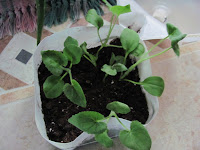Dear Iris: Christmas cactus can last for years
Perhaps you are a new caretaker/owner of a Christmas cactus or have been enjoying the easy to care for cactus for many years or even generations.
This splendid flowering houseplant shows up in stores and garden centers around Thanksgiving, usually displayed with seasonal poinsettias and amaryllis. The stems are dark green, flat pads joined in segments with flowers appearing from the areolas at the joints and ends of stems. Flowers have a crab-like shape and can be pink, coral, red, white or scarlet in color. Buds usually appear in late November. My coral flowering cactus was a gift from my mom in 1984. It has a special spot in our dining room, receiving indirect east sunlight. Fresh buds, gradually flowering, are a glowing reminder of my mom and dad, year after year.
The genus Schlumbergera truncata are quite easily cared for. This tropical succulent should be repotted every two to three years or longer. It enjoys being root bound. The soil should be barely moist, but not too dry. Shriveled, limp looking stems are telling you it’s too dry. After flowering, water sparingly until spring when new growth should begin. Fifty percent to 60 percent humidity is ideal. Standing the pot on a tray of wet pebbles can regulate this. When repotting, use equal parts of a potting soil mix and fine grade fir bark. Fertilize every couple of weeks. When blooming has stopped, wait a month before fertilizing again. Use a fertilizer recommended for blooming houseplants that can be purchased at any garden center.
Long-time owners of Christmas cacti have rituals, faithfully used year after year to achieve long-lasting flowering. My mother-in-law moves her hot pink cactus outside in late spring when danger of frost is past. Their new home for the summer is located on the north side of her house between the house and 3- foot yew shrubs. Here it is somewhat protected, watered by Mother Nature and has varying temperatures of night and day in Iowa. The northern exposure provides bright, indirect light.
This unscientific formula has amazing results. When cooler weather arrives and cactus life in the house returns, the plant receives indirect southern light and budding begins. The faithful cactus bursts open again and again with those crab shaped flowers.
I admire her ritual and the results it brings, but I haven’t used it. It is too risky for me, and the fear of the unknown, unwanted creatures at our farm homestead, dismisses any thoughts of taking my gifted cactus outside! It remains safely standing in the dining room, and it, too, loyally bursts forth in bloom. This continues right through our family Christmas dinner, a beautiful reminder of earlier days with my folks.
Pruning will encourage the Christmas cactus to branch out where stems are cut. This will create a fuller plant. Springtime is best for pruning when it is actively growing. While you are performing this task, why not propagate for family, friends, maybe grandchildren?
This is easily accomplished by placing stem segments upright in moist perlite. The results? A blooming, forgiving, easy to care for houseplant! Who knows what special memory or care method might develop when this plant is shared.
As part of our Master Gardening training, we toured the greenhouses at the Iowa State University horticulture buildings. Students had propagations of Christmas cactus in perlite along with many other plant species. They were simply started in moist perlite! How wonderful!
Gerri Lyon is a Master Gardener intern.
EDITOR’S NOTE: Questions are welcome and can be directed to Master Gardner Intern and Ledger photographer Julie Johnston at photo@ffledger.com.









